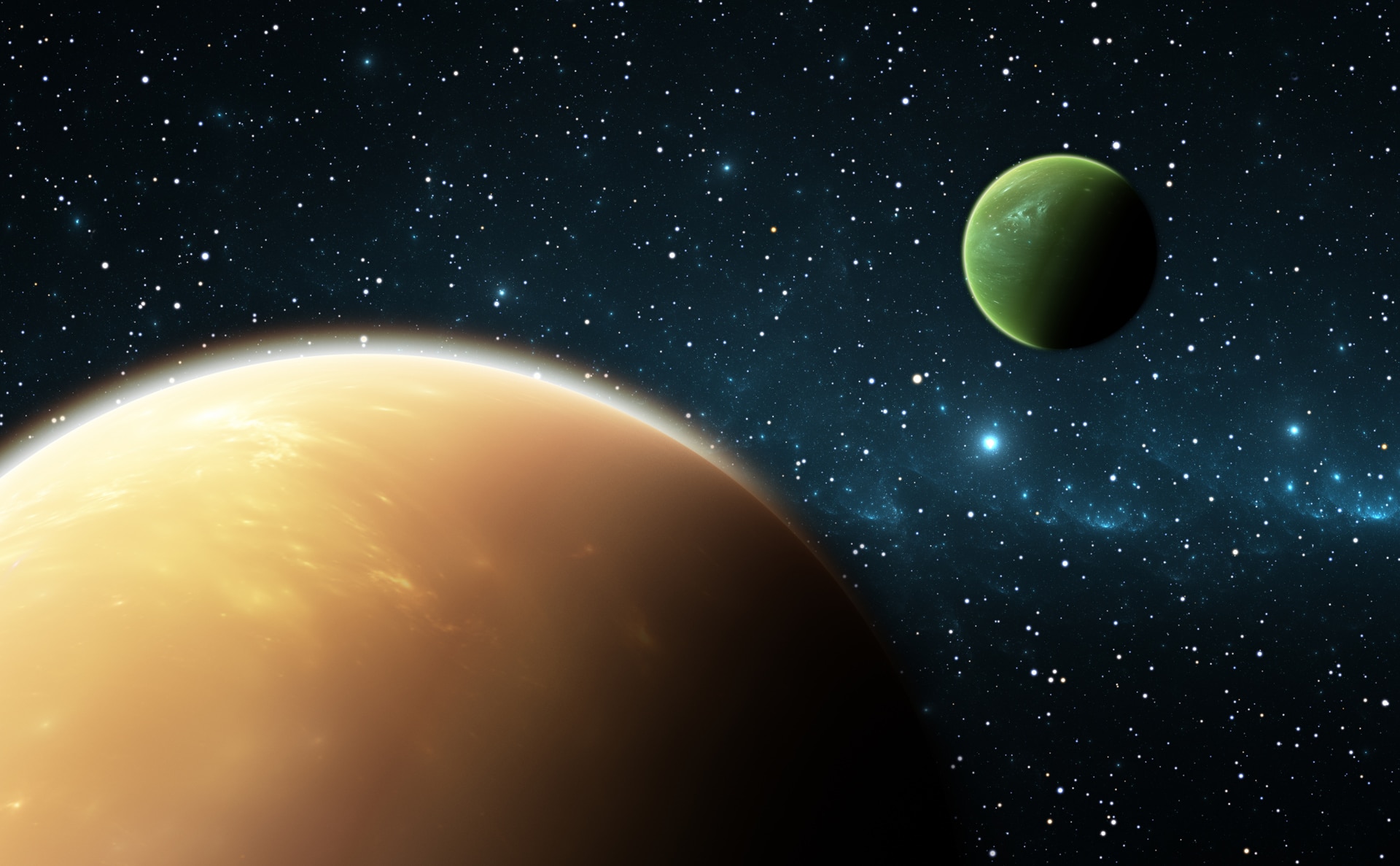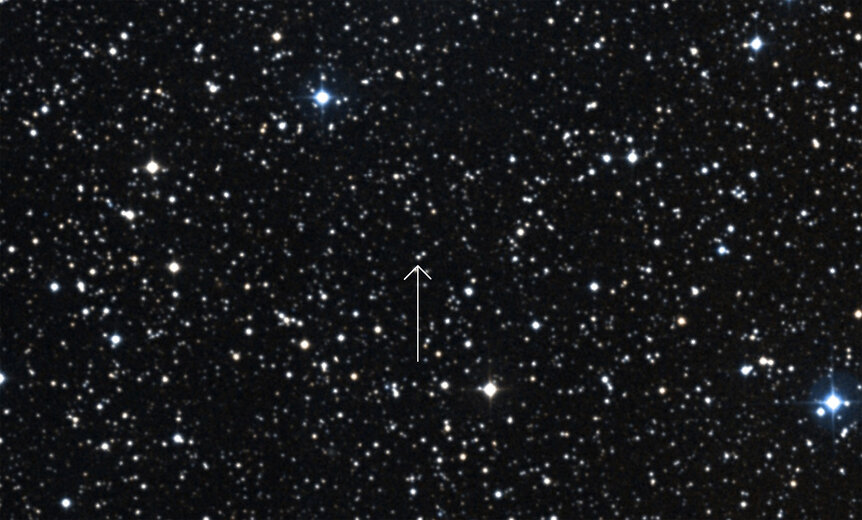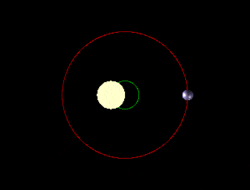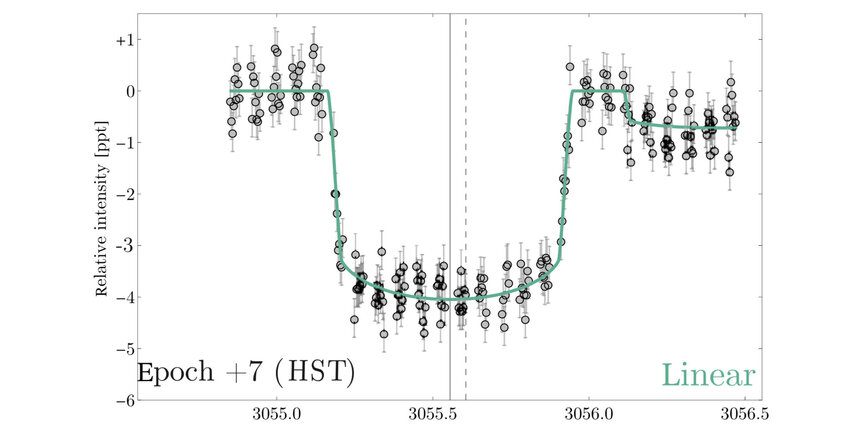Create a free profile to get unlimited access to exclusive videos, sweepstakes, and more!
More evidence piles up that we’re seeing an exomoon orbiting an alien world

At this moment, astronomers have found nearly 4,000 exoplanets, alien worlds orbiting alien stars. But for all that, we still haven't found a single exomoon, a satellite of one of those worlds.
Except, maybe we have. It's not clear.
Kepler-1625 is a star a smidgen over 8,000 light years from Earth. Orbiting it is at least one exoplanet; the only we know of around that star so far. Called Kepler-1625b, it's a big planet: It's just about the same size as Jupiter, over 11 times wider than Earth. The mass isn't known, but it may be around 1,000 times the mass of Earth (so, roughly three times Jupiter's mass).
Our own Jupiter has a lot of moons. A lot: 79 are known so far, ranging in size from Ganymede, which is bigger than Mercury, down to piddly little rocks barely a few kilometers across. So it's not ridiculous to think Kepler-1625b has moons, too.
The problem is detecting them. Even a Ganymede-equivalent would be incredibly difficult to find using current tech at that distance.
But here's the fun bit: Observations of Kepler-1625b hint strongly that a moon is there. That's been known for a couple of years. The really fun bit? New Hubble observations lend strong credence to this!
Now before I get into details, let me be very clear: This exomoon has not yet been confirmed to exist! The astronomers involved are very careful to make this point over and again in their paper (heck, they even titled the paper "Evidence for a large exomoon orbiting Kepler-1625b", not "Discovery of a large exomoon"). But the new data are quite compelling for a couple of reasons, which I'll explain. If I had to bet, at even odds I'd wager a small amount of cash on this exomoon being real.
So what's the deal?
The planet was first seen by the NASA Kepler observatory, a space-based telescope. For years it stared at one spot in the sky with about 150,000 stars in it, measuring their brightnesses carefully and often. It was looking for dips in the light, called transits, caused by orbiting planets. If we happen to see that orbit edge on, the planet will block a little bit of the star as seen from Earth, creating a mini-eclipse. By measuring the amount of light blocked the size of the planet can be found, and the length of the eclipse tells us the time it takes the planet to orbit. Transit observations are tricky, but an extremely powerful way to find and characterize exoplanets.
In a paper published in 2017, astronomers reported analyzing known exoplanet data to look for exomoons. The idea is that if an exoplanet has a moon, you might see an irregularity in the transit data, an extra dip before or after the main one, if the moon leads or trails the planet at the time of the transit. It might also happen during the main transit, distorting the profile shape of the dip. Either way it would be a much shallower dip, and even harder to detect, so they looked at nearly 300 transits to search for moons.
Only one good candidate turned up, which they called Kepler-1625b I (planets are named after their host star with a lower case letter after, starting with b and incremented in order of discovery; there is no official rule for exomoons, so the astronomers added an I after). It appeared in three different transits of the exoplanet at different times, which is what you expect: The moon would orbit the planet, so sometimes it will be on one side or the other during the various transits.
The data were rather stunning: The size of the dip implied the exomoon was very large, roughly four times wider than Earth! That would make it more like Neptune than any moon in our solar system, so that's really weird. It's not clear how such a huge moon could wind up orbiting an even bigger gas giant, but physics doesn't preclude it. If true, the vast moon orbits the planet at a distance of about 3 million kilometers, about eight times farther out than our Moon orbits Earth; far, but still stable over the lifetime of the system.
This provoked the team to write my favorite line in their paper: "One jarring aspect of the system is the sheer scale of it." Yeah, yikes.
Still, the problem was the data were inconclusive. Provocative, yes, but not definitive.
So they did what a lot of astronomers do when their data is on the edge of believability: Get a bigger 'scope. So they used Hubble.
They procured 40 hours of time on the orbiting telescope, observing Kepler-1625 using a spectrograph that breaks the light up into individual colors (I'll get back to this in a sec). They also did something clever: They started their observations long before the actual predicted transit time and continued them long after, to make absolutely sure they caught it. And it was a good thing they did.
They saw the transit of the exoplanet, but it started about 78 minutes earlier than predicted! And, oh, that's very interesting indeed. Why?
Because the moon is massive, it pulls on the planet pretty hard as it orbits. The moon makes a big circle, but the planet makes a smaller one, both orbiting their center of mass, staying on opposite side of it (like two kids on a seesaw with the fulcrum between them). This is called reflex motion. In the case of Kepler-1625b, the moon is massive enough to throw the planet around quite a bit, which can affect the timing of the transit.
Because of this, since the transit started early, you'd expect the moon to transit after the planet.
And that's just what they saw. In the Hubble data there is a faint but traceable second dip in the star's light, following the main planet transit, and lasting for about the time you'd think for a moon of the size predicted from the Kepler data.
Hmmmmm.
The problem again is that the data still aren't conclusive. The second dip doesn't really scream out (and, sadly, the observations end before the alleged exomoon transit does). The astronomers used a variety of methods to analyze the data to make sure it was real*. It looks pretty good, but how good changes with the method used. I would say they were extraordinarily careful with their processing, looking for artifacts in the detector (literally issues with the camera used that could mimic a signal from the moon), stellar variations (like activity on the star's surface), and more, but nothing came up. Remember too they used a spectrometer, which lets them analyze colors during the transit. Stellar activity, for example, would appear different in different colors, while a moon transiting would be agnostic to color. They saw no color variation, consistent with a moon.
They therefore conclude that what they see is probably astrophysical — that is, caused by an astronomical object — but even now they can't say for sure it's an exomoon.
That's frustrating. But sometimes, that's science.
They hope to observe this system again with Hubble, and they recommend looking at other giant transiting planets with bigger and better 'scopes to look for exomoons, too.
As they note: The first exoplanet detection was fraught with skepticism, and (rightly!) it wasn't for some years before the astronomical community was convinced they were real. The same will be true here. Even if this exomoon doesn't pan out, we're bound to start finding them eventually.
We might as well start now.
*Trending is a serious issue, where the data seems to change over time due to internal effects in the detector. Another group of astronomers questioned the original Kepler observation results, and talked with David Kipping, one of the astronomers looking at the Kepler-1625b data. He said they did everything they could to minimize this, and in fact the new Hubble data doesn't have the same problem, supporting the idea that this moon exists.





























